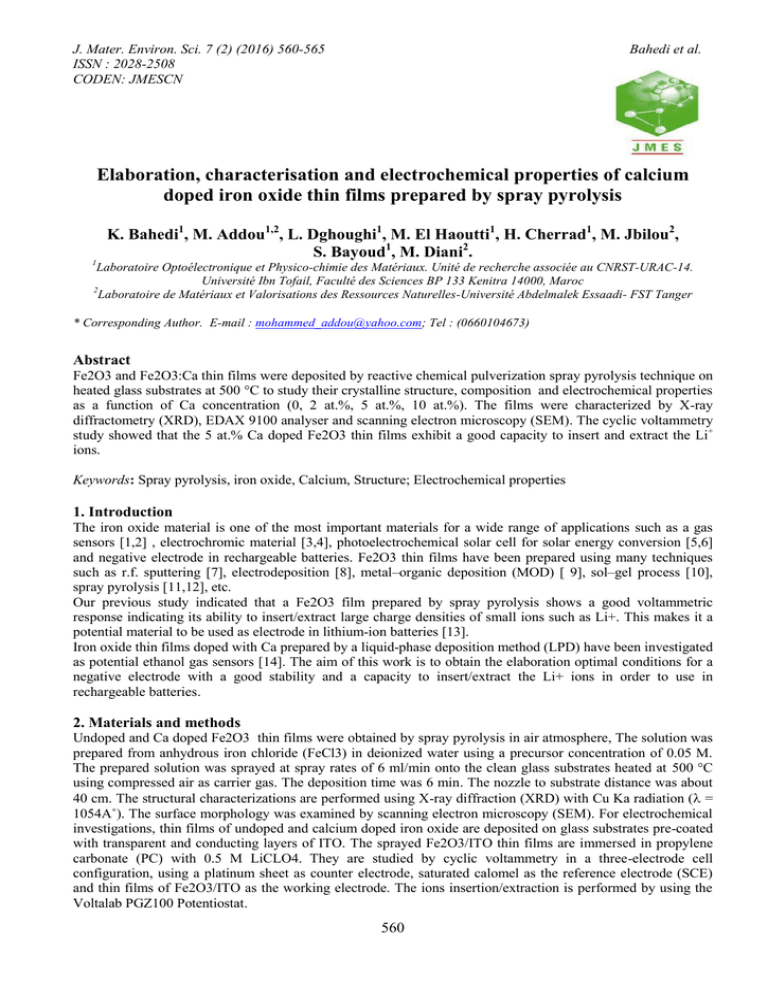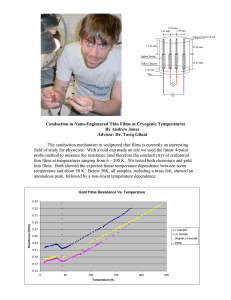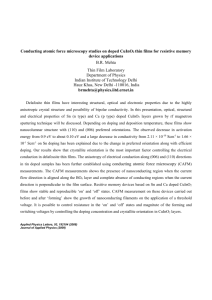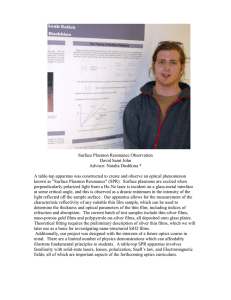Electrochemical properties of calcium doped iron oxide thin films
advertisement

J. Mater. Environ. Sci. 7 (2) (2016) 560-565 ISSN : 2028-2508 CODEN: JMESCN Bahedi et al. Elaboration, characterisation and electrochemical properties of calcium doped iron oxide thin films prepared by spray pyrolysis K. Bahedi1, M. Addou1,2, L. Dghoughi1, M. El Haoutti1, H. Cherrad1, M. Jbilou2, S. Bayoud1, M. Diani2. 1 Laboratoire Optoélectronique et Physico-chimie des Matériaux. Unité de recherche associée au CNRST-URAC-14. Université Ibn Tofail, Faculté des Sciences BP 133 Kenitra 14000, Maroc 2 Laboratoire de Matériaux et Valorisations des Ressources Naturelles-Université Abdelmalek Essaadi- FST Tanger * Corresponding Author. E-mail : mohammed_addou@yahoo.com; Tel : (0660104673) Abstract Fe2O3 and Fe2O3:Ca thin films were deposited by reactive chemical pulverization spray pyrolysis technique on heated glass substrates at 500 °C to study their crystalline structure, composition and electrochemical properties as a function of Ca concentration (0, 2 at.%, 5 at.%, 10 at.%). The films were characterized by X-ray diffractometry (XRD), EDAX 9100 analyser and scanning electron microscopy (SEM). The cyclic voltammetry study showed that the 5 at.% Ca doped Fe2O3 thin films exhibit a good capacity to insert and extract the Li+ ions. Keywords: Spray pyrolysis, iron oxide, Calcium, Structure; Electrochemical properties 1. Introduction The iron oxide material is one of the most important materials for a wide range of applications such as a gas sensors [1,2] , electrochromic material [3,4], photoelectrochemical solar cell for solar energy conversion [5,6] and negative electrode in rechargeable batteries. Fe2O3 thin films have been prepared using many techniques such as r.f. sputtering [7], electrodeposition [8], metal–organic deposition (MOD) [ 9], sol–gel process [10], spray pyrolysis [11,12], etc. Our previous study indicated that a Fe2O3 film prepared by spray pyrolysis shows a good voltammetric response indicating its ability to insert/extract large charge densities of small ions such as Li+. This makes it a potential material to be used as electrode in lithium-ion batteries [13]. Iron oxide thin films doped with Ca prepared by a liquid-phase deposition method (LPD) have been investigated as potential ethanol gas sensors [14]. The aim of this work is to obtain the elaboration optimal conditions for a negative electrode with a good stability and a capacity to insert/extract the Li+ ions in order to use in rechargeable batteries. 2. Materials and methods Undoped and Ca doped Fe2O3 thin films were obtained by spray pyrolysis in air atmosphere, The solution was prepared from anhydrous iron chloride (FeCl3) in deionized water using a precursor concentration of 0.05 M. The prepared solution was sprayed at spray rates of 6 ml/min onto the clean glass substrates heated at 500 °C using compressed air as carrier gas. The deposition time was 6 min. The nozzle to substrate distance was about 40 cm. The structural characterizations are performed using X-ray diffraction (XRD) with Cu Ka radiation ( = 1054A˚). The surface morphology was examined by scanning electron microscopy (SEM). For electrochemical investigations, thin films of undoped and calcium doped iron oxide are deposited on glass substrates pre-coated with transparent and conducting layers of ITO. The sprayed Fe2O3/ITO thin films are immersed in propylene carbonate (PC) with 0.5 M LiCLO4. They are studied by cyclic voltammetry in a three-electrode cell configuration, using a platinum sheet as counter electrode, saturated calomel as the reference electrode (SCE) and thin films of Fe2O3/ITO as the working electrode. The ions insertion/extraction is performed by using the Voltalab PGZ100 Potentiostat. 560 J. Mater. Environ. Sci. 7 (2) (2016) 560-565 ISSN : 2028-2508 CODEN: JMESCN Bahedi et al. 3. Results and discussion 3.1 X-ray diffraction (XRD) Figure 1 reports XRD spectra of the undoped and calcium doped Fe2O3 thin films deposited on glass substrates grown at 500 °C with an atomic concentration of 2 at.%, 5 at.% and 10 at.%. The films crystallized in the rhombohedral (hexagonal hematite α-Fe2O3, the PDF numbers 72-0469 and 24-0072) structure with a preferred orientation along the (104) direction, while peaks associated to Ca are not observed. Figure 1: X-ray diffraction spectra of undoped and Ca doped Fe2O3 thin films 3.2 Composition and Surface morphology Composite of the undoped and calcium doped Fe2O3 thin films were measured by EDAX analysis. Figure 2 shows the energy dispersive X-ray spectra of thin films doped with 5% Ca. As we can see, the spectrum reveals the existence of all expected elements, Fe, O and Ca atoms and some impurity as silica originated from the substrate. Figure 3: shows SEM micrographs of Ca doped Fe2O3 films. All films show morphology with crystallites in the spherical form. We can see that 5 at.% Ca doped films are distinguished by a uniform grain size. 3.3 Electrochemical characterisation The electrochemical characteristics of Fe2O3 and Ca doped Fe2O3 deposited on thin films of ITO are studied by recording the cyclic – voltammogrames (CV) in a propylene carbonate (PC) solution with 0.5 M of the lithium perchlorate trihydrate (LiClO4). 561 J. Mater. Environ. Sci. 7 (2) (2016) 560-565 ISSN : 2028-2508 CODEN: JMESCN Bahedi et al. Figure 2: EDAX spectrum of Fe2O3:5 at.%Ca thin films (a) (b) (c) Figure 3: SEM micrographs of: (a) 2 at.%, (b) 5 at.%, and (c) 10 at.% Ca doped Fe2O3 thin films. The cyclic voltammogram of undoped Fe2O3/ITO films with applied potential between -1.5 and 1.5V versus (SCE) are illustrated in figure 4. It can be seen that the films favours the Li+ intercalation/des-intercalation process, as we reported in our earlier work [13]. We are varied the concentration of the LiClO4 propylene carbonate in order to investigate its effect on the insertion /extraction of the Li+ ions. Figure 5 shows the cyclic voltammogrames of undoped Fe2O3/ITO films in a solution with 0.5 M and 1 M of the LiClO4. Figure 4: Cyclic voltammograms of undoped Fe2O3 Figure 5: Cyclic voltammograms of undoped Fe2O3 thin film in 0.5 M of LiClO4 propylene carbonate. The thin film in 0.5 M and 1 M of LiClO4 propylene scan rate is 50 mv/s. carbonate. The scan rate is 50 mv/s. 562 J. Mater. Environ. Sci. 7 (2) (2016) 560-565 ISSN : 2028-2508 CODEN: JMESCN Bahedi et al. It can be seen that the increase of the LiClO4 concentration in the solution lead to narrowing the cyclic voltammogramm of the films, indicating a decrease of the Li+ intercalation/des-intercalation process. We can conclude that there may be a relationship between the concentration of Li+ ions in the solution and their mobility witch can be controlled by the scan rate. In order to investigate the doping effect by calcium, we are recorded the cyclic voltammogramms of the undoped and 2 at.%, 5 at.%, 10 at.% Ca doped films (figure 6 ). We can see that the insertion of calcium favours the capability to insert /extract the Li+ ions. films doped 5 at.% of Ca show an open cyclic than undoped films, and the curve shape illustrate the existence of tow large anodic current peaks A and B corresponding to the oxidation states of thin films and the cathodic current peak C corresponding to the reduction state of thin films. It is concluded that the doping of the Fe2O3 by calcium illustrate a significantly reduction/oxydation phenomena for the optimal conditions, indicating a good voltammetric response. The cyclics voltammogramms stability of Fe2O3:5 at %Ca thin films has being studied by recording 5 cycles of the oxydo/reduction process ( Figure 8), we can see that the cycles are reproductible. Figure 6: Cyclic voltammograms of undoped and Ca doped Fe2O3 thin film in 0.5 M of LiClO4 propylene carbonate. The scan rate is 50 mv/s. 563 J. Mater. Environ. Sci. 7 (2) (2016) 560-565 ISSN : 2028-2508 CODEN: JMESCN Bahedi et al. Figure 7: Comparisons of the cyclics voltammogrammes Figure 8: 5 cyclics voltammogrammes recorded for Fe2O3:5 at.%Ca thin films. Conclusion The highly oriented Fe2O3 thin films were deposited by the spray pyrolisis technique onto the glass substrates. XRD diffraction studies reveal the polycrystalline nature of the films. The electrochemical study shows that Ca doped Fe2O3 thin films have a good voltammetric response and a good stability especially at optimal conditions, indicating their ability to insert/extract a large charge densities of small ions such as Li. The obtained experimental data demonstrate that the deposited films can be used as electrode in lithium-ion batteries. Acknowledgements-This work was financially supported by the Project Hassan II Academy of Science and Technology, and PPR/2015/9 Project. 564 J. Mater. Environ. Sci. 7 (2) (2016) 560-565 ISSN : 2028-2508 CODEN: JMESCN Bahedi et al. References 1. Siroky K., Jiresova J., Hudec L., Thin Solid Films 245 (1994) 211–214. 2. Lee, D-D., Choi D-H., Sens. Actuators B 1 (1990) 231. 3. Orel B., Macek M., Svegl F., Thin Solid Films 246 (1994) 131. 4. Zotti G., Schiavon G., Sandro Zecchin S., J. Electrochem. Soc. 145 (2) (1998) 385. 5. Patil P.S., Lokhande C.D., Pawar S.H., Bull. Electrochem. 5 (1989). 6. Kennedy J.H., Dunnwald D.J., Electrochem. Soc. 130 (1983) 2013. 7. Shinar R., Kennedy J.H., Solar Energy Matter. 76 (1982) 323. 8. Kulkani S.S., Lkhande C.D., Mater. Chem. Phys. 82 (2003) 151. 9. Pal B., Sharon M., Thin Solid Films 379 (2000) 83. 10. Ozer N., Tepehan F., Solar Energy Solar Cells 56 (1999) 141. 11. Akl A.A., Appl. Surf. Sci. 221 (2004) 319. 12. Akl A.A., Appl. Surf. Sci. 233 (2004) 307. 13. Dghoughi L., Elidrissi B., Bernéde C., Addou M., Alaoui Lamrani M., Regragui M., Erguig H., Applied Surface Science 253 (2006) 1823–1829. 14. Neri G., Bonavita A., Ipsale S., Rizzo G., Baratto C., Faglia G., Sberveglieri G., Materials Science and Engineering B 139 (2007) 41–47. (2016) ; http://www.jmaterenvironsci.com 565





